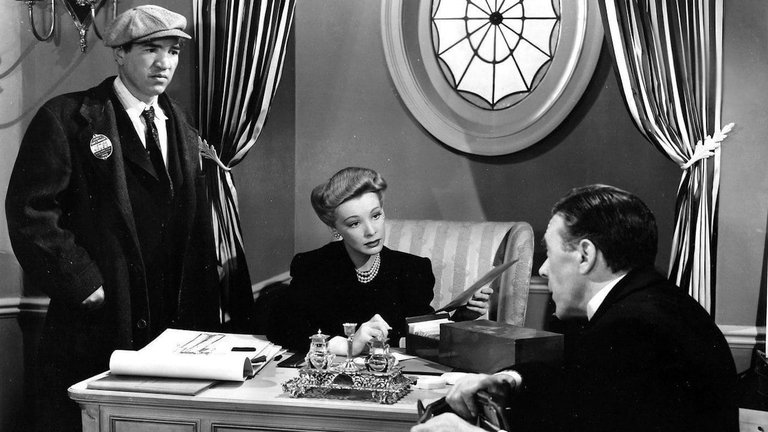Film Review: The House on 92nd Street (1945)

Harsh realities of Second World War influenced Hollywood crime films through two, sometimes conflicting, trends. Its content became, figuratively and literally, darker, developing a style that would become known as “film noir”. On the other hand, number of mid 1940s crime films discarded Hollywood’s artificiality in an extreme fashion and embraced realism in the way that brand them “semi-documentarian”. One of the best known and the most successful examples of the latter trend in The House on 92nd Street, 1945 spy thriller directed by Henry Hathaway.
Made during the last months of the war, The House on 92nd Street is based on the real story that took place few years earlier and represented one of the greatest triumphs in the FBI history. The plot deals with efforts of FBI agents led by Special Agent Briggs (played by Lloyd Nolan) to catch “Christopher”, mysterious leader of German spy ring in USA. Their key asset in that task will be Bill Dietrich (played by William Eythe), brilliant university student of German descent who in 1939, when USA and Nazi Germany have been still at peace, became approached by Nazis to work for them. He immediately contacted FBI and, later, volunteered to become double agent. He visits Germany where he would attend spy school in Hamburg. Upon return to America, he comes to New York City where he would get in touch with other German agents that include dress designer Elsa Gebhardt (played by Signe Sasso) and veteran spy Colonel Hammersohn (played by Leo G. Carroll). Dietrich is tasked with operating radio station at Long Island that would transmit information gathered by spies. He sets up low-range station, which relays that information to long-range station run by FBI. As this deception continues, Briggs’ investigation becomes crucial for war effort, because German spies have became aware of “Process 97”, top secret US government project that involves creation of atomic weapon. Dietrich must find identity of “Christopher” in order for his ring to be dismantled before it could provide precious information to Nazi Germany.
The House on 92nd Street holds distinction as one of the first Hollywood live action films to use US atomic bomb as part of its plot. When the film was actually produced, its creators, like almost anyone else in the world, didn’t have a clue about Manhattan Project and all references to nuclear weapons were hastily added into voice-over narration after the atomic bombings of Hiroshima and Nagasaki. The actual espionage affair which served as basis for the plot occurred in 1941 and involved ring of spies and saboteurs led by Fritz Joubert Duquesne. Its dismantling, which has occurred few months before Pearl Harbor, more or less ended any German covert activity in United States. FBI director J. E. Edgar Hoover was quite proud of that achievement and used it to promote himself and his agency through propaganda film. FBI has shown unprecedented levels of co-operation with 20th Century Fox studio, allowing depiction of its files, secretly made films, forensic techniques and having actual FBI agents as extras. This kind of reconstruction, in a way similar to true crime documentaries we might see on various television channels and streaming services today, found perfect producer in Louis de Rochemont, creator of March of Time newsreels. He matched documentary footage with explanatory narration, while director Henry Hathaway insisted on using authentic locations instead artificial studio sets in live action segments. The result is live action film that looks and feels like documentary, which is the reason why it is sometimes seen as one of the first true docudramas of Hollywood.
While this semi-documentary approach, mixed with propaganda and celebration of FBI as efficient and valuable protector of national security, found its audience in post-war America, viewers today are more likely to find The House of 92nd Street lacking as proper spy thriller. Much of that lies in script that adheres to rather non-glamourous realities of espionage only to artificially spice up near the end, including scenes of interrogation, shootouts and something that looked like a rather bold and unexpected plot twist fo 1940s Hollywood standards. Many of the film’s problems might be attributed to William Eythe, who doesn’t delivers anything other than good looks as semi-protagonist. Supporting cast, which includes Leo G. Carroll, veteran of Hitchcock’s films, is much more impressive and same can be said of Swedish actress Signe Sasso as ice cold and ruthless female spymaster. Character actor Lloyd Nolan, on the other hand, deliver goods as no-nonsense FBI agent. The House of 92nd Street was successful at the box office and Nolan three years later repeated his role in The Street with No Name, thriller dealing with organised crime. Other crime films copied its approach, most notably Boomerang! and The Naked City. Today’s audience, at least those with little interest in history, are more see this film as curiosity rather than particularly remarkable piece of genre cinema.
RATING: 6/10 (++)
_
Blog in Croatian https://draxblog.com
Blog in English https://draxreview.wordpress.com/
Leofinance blog https://inleo.io/@drax.leo
InLeo: https://inleo.io/signup?referral=drax.leo
Stars Arena: https://www.starsarena.com/?ref=draxblog
Unstoppable Domains: https://unstoppabledomains.com/?ref=3fc23fc42c1b417
Hiveonboard: https://hiveonboard.com?ref=drax y
Bitcoin Lightning HIVE donations: https://v4v.app/v1/lnurlp/qrcode/drax
Rising Star game: https://www.risingstargame.com?referrer=drax
1Inch: https://1inch.exchange/#/r/0x83823d8CCB74F828148258BB4457642124b1328e
BTC donations: 1EWxiMiP6iiG9rger3NuUSd6HByaxQWafG
ETH donations: 0xB305F144323b99e6f8b1d66f5D7DE78B498C32A7
